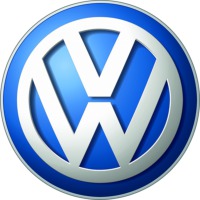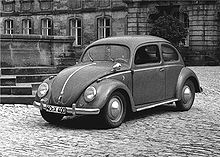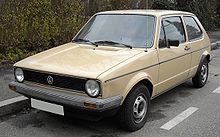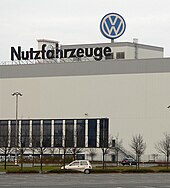
世界百大品牌 – Rank no.34 – Germany
Top 100 Brand in The World – Rank no.34 – Volkswagen Group – Germany
 |
|
| Type | Public |
|---|---|
| Traded as | FWB: VOW VOW3 OTCQX: VLKAY |
| Industry | Automotive |
| Founded | Berlin, Germany (28 May 1937) |
| Headquarters | Wolfsburg, Germany |
| Number of locations | 100 production facilities across 27 countries |
| Area served | Worldwide |
| Key people | Ferdinand K. Piëch (Chairman)Martin Winterkorn (CEO) |
| Products | Automobiles, commercial vehicles,engines, motorcycles, turbomachinery |
| Production output | |
| Services | Banking, financing, fleet management, insurance, leasing[2] |
| Revenue | |
| Operating income | |
| Profit | |
| Total assets | |
| Total equity | |
| Employees | 549,763 (2012)[7] |
| Divisions |
|
| Subsidiaries | |
| Website | volkswagenag.com |
Volkswagen Group (parent company Volkswagen Aktiengesellschaft) is a multinational automotive company headquartered inWolfsburg, Lower Saxony, Germany. It designs, manufactures and distributes passenger and commercial vehicles, motorcycles, engines, and turbomachinery and offers related services including financing, leasing and fleet management. In 2012, it produced the third-largest number of motor vehicles of any company in the world, behind General Motors and Toyota.[9] It has maintained the largest market share in Europe for over two decades.[10] As of 2013, it ranked ninth in the Fortune Global 500 list of the world’s largest companies.[11]
Volkswagen Group sells passenger cars under the Audi, Bentley, Bugatti, Lamborghini, Porsche, SEAT, Škoda and Volkswagenmarques; motorcycles under the Ducati brand; and commercial vehicles under the MAN, Scania and Volkswagen Commercial Vehicles marques.[12] It is divided into two primary divisions, the Automotive Division and the Financial Services Division, and has approximately 340 subsidiary companies.[13] The company has operations in approximately 150 countries and operates 100 production facilities across 27 countries. It holds a 19.9% non-controlling shareholding in Suzuki and has two major joint-ventures in China—FAW-Volkswagen and Shanghai Volkswagen.
Volkswagen was founded in 1937 to manufacture the car which would become known as the Beetle. The company’s production grew rapidly in the 1950s and 1960s, and in 1965 it acquired Auto Union, which subsequently produced the first post-war Audi models. Volkswagen launched a new generation of front-wheel drive vehicles in the 1970s, including the Passat, Polo and Golf; the latter became its bestseller. Volkswagen acquired a controlling stake in SEAT in 1986, making it the first non-German marque of the company, and acquired control of Škoda in 1994, of Bentley, Lamborghini and Bugatti in 1998, Scania in 2008 and of Ducati, MAN and Porsche in 2012. The company’s operations in China have grown rapidly in the past decade with the country becoming its largest market.
Volkswagen Aktiengesellschaft is a public company and has a primary listing on the Frankfurt Stock Exchange, where it is a constituent of the DAX index, and secondary listings on the London Stock Exchange, Luxembourg Stock Exchange, New York Stock Exchange and SIX Swiss Exchange. As of September 2012, the government of Lower Saxony holds 12.7% of the company’s shares, granting it 20% of the voting rights.
History[edit]
1937 to 1970[edit]

A 1951 Volkswagen Beetle
Volkswagen was founded on 28 May 1937 as the Gesellschaft zur Vorbereitung des Deutschen Volkswagens mbH (“Society for the preparation of the German People’s Car”, abbreviated to Gezuvor) by the National Socialist Deutsche Arbeitsfront (German Labour Front).[15][16][17] The purpose of the company was to manufacture the Volkswagen car, originally referred to as the Porsche Type 60, then the Volkswagen Type 1, and commonly called the Volkswagen Beetle.[18] This vehicle was designed by Ferdinand Porsche‘s consulting firm, and the company was backed by the support of Adolf Hitler.[19] On 16 September 1938, Gezuvor was renamedVolkswagenwerk GmbH (“Volkswagen Factory limited liability company”).[15]
Shortly after the factory near Fallersleben was completed, World War II was started and the plant primarily manufactured the militaryKübelwagen (Porsche Type 82) and the related amphibious Schwimmwagen (Type 166), both of which were derived from the Volkswagen. Only a small number of Type 60 Volkswagens were made during this time period. The Fallersleben plant also manufactured the V-1 flying bomb, making the plant a major bombing target for the Allied forces. Much of the workforce at the plant was slave labor, primarily from eastern Europe.
After the war in Europe, in June 1945, Major Ivan Hirst[18] of the British Army Royal Electrical and Mechanical Engineers (REME) took control of the bomb-shattered factory, and restarted production, pending the expected disposal of the plant as war reparations. However, no British car manufacturer was interested; “the vehicle does not meet the fundamental technical requirement of a motor-car … it is quite unattractive to the average buyer … To build the car commercially would be a completely uneconomic enterprise”.[20]In 1948, the Ford Motor Company of USA was offered Volkswagen, but Ernest Breech, a Ford executive vice president said he didn’t think either the plant or the car was “worth a damn.”[21] As part of the Industrial plans for Germany, large parts of German industry, including Volkswagen, were to be dismantled. Total German car production was set at a maximum of 10% of the 1936 car production numbers.[22] The company survived by producing cars for the British Army, and in 1948, the British Government handed the company back over to the German state, where it was managed by former-Opel chief Heinrich Nordhoff.

The Audi F103, in production from 1965 to 1972
Production of the Type 60 Volkswagen (re-designated Type 1) started slowly after the war due to the need to rebuild the plant and because of the lack of raw materials, but production grew rapidly in the 1950s and 1960s. The company began introducing new models based on the Type 1, all with the same basic air-cooled, rear-engine, rear-drive platform. These included the Volkswagen Type 2 in 1950, the Volkswagen Karmann Ghia in 1955, the Volkswagen Type 3 in 1961, the Volkswagen Type 4 in 1968, and the Volkswagen Type 181in 1969.
In 1960, upon the flotation of part of the German federal government’s stake in the company on the German stock market, its name became Volkswagenwerk Aktiengesellschaft (usually abbreviated to Volkswagenwerk AG).
On 1 January 1965, Volkswagenwerk acquired Auto Union GmbH from its parent company Daimler-Benz. The new subsidiary went on to produce the first post-war Audi models, the Audi F103 series, shortly afterwards.[23]
Another German manufacturer, NSU Motorenwerke AG, was merged into Auto Union on 26 August 1969, creating a new company, Audi NSU Auto Union AG (later renamed AUDI AG in 1985).[23]
1970 to 2000[edit]

A Volkswagen Golf Mk1; the Golf is the third best-selling car of all-time, selling over 26 million up to 2008
From the late 1970s to 1992, the acronym V.A.G was used by Volkswagen AG as a brand for group-wide activities, such as distribution and leasing. Contrary to popular belief, “V.A.G” had no official meaning, and was never the name of the Volkswagen Group.[24]
On 30 September 1982, Volkswagenwerk made its first step expanding outside of Germany by signing a co-operation agreement with the Spanish car manufacturer SEAT, S.A.[23]
In order to reflect the company’s increasing global diversification from its headquarters and main plant (the Volkswagenwerk inWolfsburg), on 4 July 1985, the company name was changed again – to Volkswagen Aktiengesellschaft (Volkswagen AG).
On 18 June 1986, Volkswagen AG acquired a 51% controlling stake in SEAT, making it the first non-German subsidiary of the Volkswagen Group. On 23 December the same year, it became the Spanish company’s major shareholder by increasing its share up to 75%.[23]
In 1990 – after purchasing its entire equity – Volkswagen AG took over the full ownership of SEAT, making the company a wholly owned subsidiary, and on 28 March 1991 another step to the expansion of the group’s activities was made through the signing of a joint venture partnership agreement with Škoda automobilová a.s. of Czechoslovakia, accompanied with the acquisition of a 30% stake in the Czech car manufacturer,[23] raised later on 19 December 1994 to 60.3% and the year after, on 11 December 1995, to 70% of its shares.[25]
Three prestige automotive marques were added to the Volkswagen portfolio in 1998: Bentley, Lamborghini and Bugatti.[23]
2000 to present[edit]

The Škoda Superb B6, in production since 2008
On 30 May 2000, Volkswagen AG, after having gradually raised its equity share, turned Škoda Auto into a wholly owned subsidiary.[23]
From 2002 up to 2007, the Volkswagen Group’s automotive division was restructured so that two major Brand Groups with differentiated profile would be formed,[26] the Audi Brand Group focused on more sporty values – consisted of Audi, SEAT and Lamborghini – and theVolkswagen Brand Group on the field of classic values – consisted of Volkswagen, Skoda, Bentley and Bugatti[27][28] – with each Brand Group’s product vehicles and performance being respectively under the higher responsibility of Audi and Volkswagen brands.
Volkswagen Group revealed on 24 October 2009 that it had made an offer to acquire long-time partner and German niche automotive manufacturer Wilhelm Karmann GmbH out of bankruptcy protection.[29] In November 2009, the Supervisory Board of Volkswagen AG approved the acquisition of assets of Karmann, and plan to restart vehicle production at their Osnabrück plant in 2012.[30]
In December 2009, Volkswagen AG bought a 49.9% stake in Dr. Ing. h.c. F. Porsche AG (more commonly known as Porsche AG) in a first step towards an ‘integrated automotive group’ with Porsche.[31][32][33] The merger of Volkswagen AG and Porsche SE was scheduled to take place during the course of 2011. On 8 September 2011, it was announced that the planned merger “cannot be implemented within the time frame provided for in the Comprehensive Agreement.” As reasons, unquantifiable legal risks, including a criminal probe into the holding’s former management team were given. Both parties “remain committed to the goal of creating an integrated automotive group with Porsche and are convinced that this will take place.”[34][35] On 4 July 2012 Volkswagen group announced they would wrap up the remaining half of Porsche shares for 4.46 billion euros ($5.58 billion) on 1 August 2012 to avoid taxes of as much as 1.5 billion euros, which would have to be paid if the wrap up happened after 31 July 2014.[36] Volkswagen AG purchased the remaining stake in Porsche AG equaling 100% of the shares in Porsche Zwischenholding GmbH, effectively becoming its parent company as of 1 August 2012.[37]
Volkswagen AG completed the purchase of 19.9% of Suzuki Motor Corporation‘s issued shares on 15 January 2010.[38][39] Suzuki invested part of the amount received from Volkswagen into 1.49% percent of Volkswagen. [40] In 2011, Suzuki filed a lawsuit at an arbitration court in London requesting that Volkswagen returns the 19.9% stake.[41]
On 25 May 2010, it was announced that Volkswagen Group, through it subsidiary Lamborghini Holding S.p.A., had acquired a 90.1% stake in the Italian automotive design houseItaldesign Giugiaro.[42] In only less than three months, the transaction had been completed making the Italian firm a member of the Volkswagen Group.[43]
Operations[edit]
Rooted in Europe, the Volkswagen Group operates in 153 countries.[44] Volkswagen Passenger Cars is the Group’s original marque, and the other major subsidiaries include passenger car marques such as Audi, Bentley, Bugatti, Lamborghini, Porsche, SEAT, and Škoda. Volkswagen AG also has operations in commercial vehicles, owning Volkswagen Commercial Vehicles, along with controlling stakes in truck, bus and diesel engine manufacturers Scania AB and MAN SE.[45]
Subsidiaries and marques[edit]
The Volkswagen Group comprises 12 principal vehicle manufacturers and their corresponding marques:
- AUDI AG, the Audi Group, and the Audi marque: ~99.55% ownership;[8] the Audi marque is the sole active marque of the former Auto Union, bought from Daimler-Benz on 30 December 1964. quattro GmbH is Audi’s performance engineering and manufacturing subsidiary.[8]
- Automobili Lamborghini S.p.A., and the Lamborghini marque: 100% ownership.[8] AUDI AG acquired Lamborghini S.p.A. in September 1998.[46]

Porsche headquarters inStuttgart
- Bentley including the Bentley marque: 100% ownership by Volkswagen AG.[8] Volkswagen purchased Rolls-Royce & Bentley from Vickers on 28 July 1998,[46] however the purchase did not include the license to use the Rolls-Royce trademark on automobiles, which is controlled by Rolls-Royce Plc.[47] BMW outmaneuvered Volkswagen, succeeding in obtaining the rights to use the Rolls-Royce trademark on automobiles. From July 1998 until December 2002, BMW continued to supply engines for the Rolls-Royce Silver Seraph and the Bentley division sold cars under both the Bentley and Rolls-Royce marques, under an agreement with BMW.
- Bugatti Automobiles S.A.S., and the Bugatti marque: 100% ownership.[8] Bugatti Automobiles S.A.S. is a wholly owned subsidiary of Groupe VOLKSWAGEN France s.a.[48] Volkswagen acquired Bugatti International S.A. Holding in July 1998.[46]
- Dr. Ing. h.c. F. Porsche AG, and the Porsche marque: Volkswagen AG purchased 49.9% of the shares in Porsche Zwischenholding GmbH (the holding company of Porsche AG) in December 2009.[49] Volkswagen AG purchased the remaining stake in Porsche AG equaling 100% of the shares in Porsche Zwischenholding GmbH, effectively becoming its parent company as of 1 August 2012.[37]
- Ducati Motor Holding S.p.A. and the Ducati marque: 100% ownership by Automobili Lamborghini S.p.A.;[8] company was bought on 19 July 2012.
- MAN SE, and the MAN marque (controlling shareholder)[8] Acquired July 2011 becoming the 10th marque of the Group, 75.03% of voting rights as of 6 June 2012.
- Scania AB and the Scania marque (controlling shareholder):[8] Acquired July 2008 becoming the 9th marque of the Group, 89.2% of voting rights as of 31 December 2011.[13][50]
- SEAT, S.A. and the SEAT marque: 100% ownership;[8] initially in 1982 a co-operation agreement with AUDI AG; 51% and 75% ownership in 1986, and full ownership in 1990. SEAT was the first non-German subsidiary of the Volkswagen Group.[23]
- Škoda automobilová a.s., Škoda Auto, and the Škoda marque: 100% ownership.[8] initially in 1991 a co-operation agreement and 30% ownership;[23] 60.3% and 70% ownership on 1994 and 1995 respectively, 100% ownership since 2000[25]
- Suzuki Motor Corporation: Volkswagen AG completed the purchase of 19.9% of Suzuki Motor Corporation’s issued shares on 15 January 2010, Volkswagen AG is the biggest shareholder in Suzuki. [51]

The Volkswagen Commercial Vehicles assembly plant inHannover, Germany
- Volkswagen Commercial Vehicles (VWCV), or German: Volkswagen Nutzfahrzeuge (VWN): 100% ownership;[8] started operations as an independent entity in 1995. VWCV/VWN is in charge of all commercial vehicle developments within the Group, and has control over Scania AB and MAN SE.
- Volkswagen Passenger Cars, and the Volkswagen marque: the founding marque of the company, 100% ownership.[8]
The Group also owns five defunct marques which are managed through the companies Auto Union GmbH and NSU GmbH, both of which are 100% owned by AUDI AG:
- Auto Union (the Auto Union company, together with NSU Motorenwerke AG (NSU), were merged into “Audi NSU Auto-Union AG” in 1969. The name was shortened to “AUDI AG” in 1985, and the interlocked four-ring badge from Auto Union is still used by AUDI AG).
- Dampf-Kraft-Wagen (DKW)
- NSU Motorenwerke AG (NSU) – bought in 1969 by Volkswagen AG, and merged into “Audi NSU Auto-Union AG”; the NSU brand has not been used since 1977, whilst the former NSU manufacturing plant at Neckarsulm is still used for Audi assembly. However, the current AUDI AG shares trade under the ticker symbol “NSU”.
Corporate affairs[edit]
Ownership[edit]
| Parts of this article (those related to shareholder detail) are outdated. Please update this section to reflect recent events or newly available information. (December 2009) |
Under the Volkswagen Law, no shareholder in Volkswagen AG could exercise more than 20 percent of the firm’s voting rights, regardless of their level of stock holding.[52] In October 2005, Porsche acquired an 18.53 percent stake in the business, and in July 2006, Porsche increased that ownership to more than 25 percent. Analysts disagreed as to whether the investment was a good fit for Porsche’s strategy.[53]
On 26 March 2007, after the European Union moved against a German law that protected Volkswagen Group from takeovers,[54] Porsche took its holding to 30.9 percent, triggering a takeover bid under German law. Porsche formally announced in a press statement that it did not intend to take over Volkswagen Group, setting its offer price at the lowest possible legal value, but intended the move to avoid a competitor taking a large stake, or to stop hedge funds dismantling Volkswagen Group, which is Porsche’s most important partner.[55] On 3 March 2008, Porsche announced that it has decided to increase its Volkswagen AG stake up to 51 percent, which would be completed before the end of the year. This was announced just hours after VWAG declared it would take a majority stake in the Swedish truck and engine maker Scania.[56] On 16 September 2008, Porsche announced that the company had increased its stake in Volkswagen AG to 35 percent.[57] As of October 2008, Porsche held 42.6 percent of Volkswagen AG’s ordinary shares, and holdsstock options on another 31.5 percent.[citation needed] On 28 October 2008, Porsche announced that they effectively held over 74 percent; 42.6 percent actual shares, and the rest as convertible options. It was announced on 7 January 2009 that Porsche now owns 50.76 percent of Volkswagen AG.[58] Volkswagen AG briefly became the world’s most valuable company, as the stock price rose to over €1,000 per share as short sellers tried to cover their positions.[59]
The current share ownership of Volkswagen AG is distributed as follows:[60]
|
|
Stock market listings[edit]
Volkswagen AG shares are primarily traded on the Frankfurt Stock Exchange,[61] and are listed under the ‘VOW’ and ‘VOW3’ stock ticker symbols. First listed in August 1961, the shares were issued at a price of DM 350 per DM 100 share,[61] Volkswagen AG shares are now separated into two different types or classes: ‘ordinary shares‘ and ‘preference shares‘.[61] The ordinary shares are now traded under the WKN 766400 and ISIN DE0007664005 listings, and the preference shares under the WKN 766403 and ISIN DE0007664039 listings.[61]
Volkswagen AG shares are also listed and traded on other major domestic and worldwide stock exchanges. In Germany’s domestic exchanges, since 1961 these include those inBerlin, Düsseldorf, Hamburg, Hanover, Munich and Stuttgart. International exchanges include those in Basel (listed in 1967), Geneva (1967), Zürich (1967), Luxembourg (1979), London (1988), and New York (1988).[61]
Since the start of trading in 1961, Volkswagen AG shares have been subjected to two stock splits – the first was on 17 March 1969 when they were split at a ratio of 2:1, from a DM 100 share to a DM 50 share. The second split occurred on 6 July 1998, the DM 50 share being converted into a share of no overall nominal value, at a ratio of 1:10.[61]
From 23 December 2009, Volkswagen AG preferred shares replaced its ordinary shares in the DAX index.[62]
Leadership[edit]
| Tenure | Person(s) |
|---|---|
| 1937 to 1945 | Bodo Lafferentz, Ferdinand Porsche, Jakob Werlin[63] |
| June 1945 to December 1947 | Ivan Hirst (Royal Electrical and Mechanical Engineers)[18] |
| 1 January 1948 to April 1967 | Heinrich Nordhoff[64] |
| 1 May 1968 to September 1971 | Kurt Lotz[64] |
| 1 October 1971 to February 1975 | Rudolf Leiding[64] |
| 10 February 1975 to December 1980 | Toni Schmücker[64] |
| 1 January 1982 to December 1992 | Carl Hahn[64] |
| 1 January 1993 to 16 April 2002 | Ferdinand K. Piëch[64] |
| 16 April 2002 to 31 December 2006 | Bernd Pischetsrieder[64] |
| 1 January 2007 to present | Martin Winterkorn[64] |
Sales and market share[edit]
| Group | Units | share |
|---|---|---|
| G.M. | 9,146,340 | 11.6% |
| Volkswagen | 8,160,154 | 10.3% |
| Toyota | 8,050,181 | 10.2% |
| Top 3 automakers 2011 by global volume, based on OICA data. Market share based on OICA 2011 global total of 78,799,483 | ||
In 2010, Volkswagen Group’s largest single country market was China with 1,924,649 units delivered, followed by Germany with 1,038,596 units. Divided by regions, Western Europe is the largest market of the Volkswagen Group with 2,902,948 units in 2010, followed by Asia-Pacific with 2,145,787 units and South America with 907,778 units delivered in 2010.[65] Currently, Yanase Co., Ltd. is the exclusive retailer of all imported Volkswagen products (Volkswagen, Audi) to Japanese consumers, and has had the exclusive rights to do so since the end of World War II.
The worldwide ranking of automakers is compiled once per year by the International Organization of Motor Vehicle Manufacturers OICA. In 2011, the Volkswagen Group ranked second on the list with 8.16 million units produced globally.[66]
| Group | Units | share |
|---|---|---|
| Volkswagen | 3,677,417 | 21.2 |
| PSA | 1,805,275 | 13.5 |
| RENAULT | 1,387,645 | 10.4 |
| Top 3 automakers 2011 by EU27 volume, based on ACEA data | ||
The European ranking of automakers is compiled monthly by the European Auto Manufacturers’ Association ACEA. By the end of 2010, the Volkswagen Group was the number one automaker in Europe with 2.8 million units sold in the EU27.[67] Volkswagen has held the top spot in Europe uninterrupted for more than two decades.[68] By the middle of 2011, former global leader Toyota had fallen to place three, with GM first and Volkswagen second.[69][70]
Sponsorships[edit]
Volkswagen is heavily involved in sports sponsorship, with investments having included the 2008 Summer Olympics, the 2014 Winter Olympics,[71][72] as well as the David Beckham Academy. Volkswagen AG wholly owns the Bundesliga football side VfL Wolfsburg;[73] the company is also the shirt sponsor of Major League Soccer club D.C. United, League of Ireland Premier Division Sligo Rovers and top level of the Mexican football league system Liga MX team Puebla F.C..

